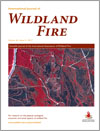International Journal of Wildland Fire
Volume 26
Number 5 2017
This paper presents a review of air quality and smoke management policies in the United States with comparisons with Australia. It discusses how the air quality regulatory framework affects wildland fire management. To be most effective, the smoke regulatory framework and fire management policy must keep pace with scientific advances as well as environmental and social change.
We explore public acceptance of smoke from several types of fires. We found the public is generally accepting of smoke, but acceptance varies by fire type. A sizable minority does not accept smoke. Perceptions of smoke-related health and non-health risks influenced acceptance of smoke from all fire types.
Fostering resilience in forest and fire management presents opportunities for scientists, managers and other constituents to work together to develop actionable scientific information. However, utilising scientific information in decision-making can be challenging. An assessment of scientific information application, development and communication was conducted, and recommendations for connecting science and decision-making are provided.
We developed MODIS-based models to predict live and dead fuel moisture for invasive tropical grasslands. Predictive models outperformed the commonly used National Fire Danger Rating System and the Keetch–Byram Drought Index. MODIS-based models will improve fire management in tropical ecosystems dominated by this widespread and problematic non-native grass.
An eastern United States wildfire hazard model updated with finer-resolution drought occurrence data is evaluated to determine if information is gained from the more detailed data. Inclusion of newer drought data shifted its contribution among monthly models to wildland–urban interface information. This refinement has removed the influence of climate division data.
We built a long-term forest fire occurrence probability model in the Karst forest management area (Slovenia) and developed spatial statistics methods using variables based on datasets of forest management plans, land use and forest fire activity. The resulting forest fire occurrence probability depends on the stands structure, species composition and the topographic parameters.
This paper examines the application of a Monte Carlo ensemble method for predicting surface fire characteristics and crowning potential (e.g. onset of crowning, type of crown fire and associated spread rate) in comparison with a deterministic one for a radiata pine (Pinus radiata) plantation fuel complex. The outputs of both approaches are assessed against data obtained from a wildfire case study.
We compared fire behaviour in different fire seasons in areas of open savanna, aiming to understand fire behaviour and to provide information to control fuel and avoid wildfires.
Patch mosaic burning aims to create landscape mosaics of varying fire ages to cater for the needs of a diversity of species, but empirical studies often fail to support this notion. Mosaics of other fire regime components such as fire frequency are thought to be important but their effects have not been tested empirically. We present empirical evidence that fly and wasp species richness responds to both kinds of fire mosaic.
This study uses an independent dataset from prescribed fire monitoring plots to validate a commonly used post-fire tree mortality model. Findings indicate that model performance was generally good but tended to consistently overpredict mortality in thin-barked species and size classes. Overpredicting mortality may have the unintended consequence of not meeting desired reductions in small tree density that is a common goal with prescribed fire treatments.




